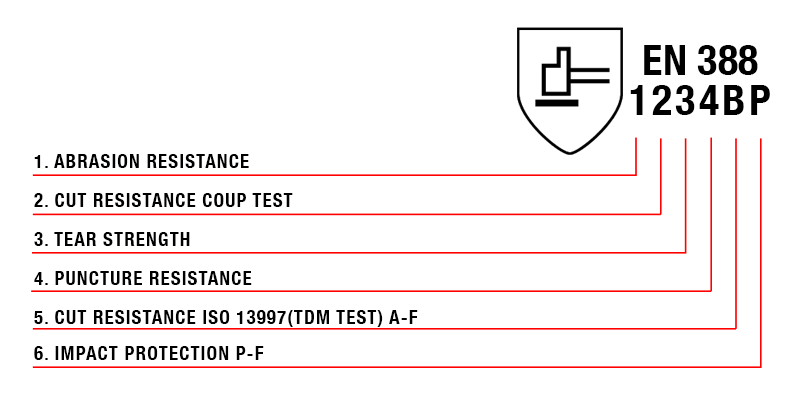EN388:2016 MECHANICAL HANDLING - New Tests explained

EN388:2016
The new revised European Standard EN 388:2016 Mechanical Handling Test is a test requirement for safety gloves that require protection against abrasion, cut, puncture, tear and impact.
a. Abrasion
The first number in the EN 388 rating is for resistance to abrasion, 180 grit abrasive paper is used on a “Martindale” type abrasion machine, which rotates the grit paper in a circular motion, the test stops when the sand paper breaks through the sample glove material.
The protection level is on a scale of 1 to 4. The higher the number is, the better the resistance to abrasion.
Performance Level | 1 | 2 | 3 | 4 |
Abrasion Resistance (cycles) | 100 | 500 | 2000 | 8000 |
b. Cut Resistance Coup Test
The second number in the EN 388 rating is for resistance to cut. A test is measured by with a rotating circular blade moving horizontally to-and-fro over the material until it cuts through. The result is specified as an index value against
a piece of canvas.
If the material dulls the knife during the test the cut test ISO 13997(TDM test) shall be performed instead.
Performance Level | 1 | 2 | 3 | 4 |
Blade Cut Resistance (Coupe test) | 1.2 | 2.5 | 5.0 | 10.0 |
c. Tear Resistance
A trouser leg shaped piece of glove material is clamped top and bottom in a standard tensile test machine.
The material is then pulled apart until it tears, the force exerted is tested in Newtons, and the corresponding number shown on the table below:
Performance Level | 1 | 2 | 3 | 4 |
Tear Resistance (Newtons) | 10 | 25 | 50 | 75 |
d. Puncture Resistance
This test uses a rounded point metal stylus which is pushed using a tensile test machine through the material at a fixed speed and the force that is required to penetrate through the material is measured in Newtons.
The protection level is indicated by a number between 1 and 4, 4 being the highest protection.
Performance Level | 1 | 2 | 3 | 4 |
Puncture Resistance (Newtons) | 20 | 60 | 100 | 150 |
e. Cut resistance, TDM test ISO 13997
If the knife gets dull during the coupe test, this test shall be performed instead. The result is given by a letter, A to F, where F indicates the highest level of protection. If any of these letters is given, this method determines the protection level instead of the coup test. (a more detailed explanation of this test can be found HERE)
Performance Level | A | B | C | D | E | F |
EN ISO Cut Resistance (Newtons) | 2 | 5 | 10 | 15 | 22 | 30 |
f. Impact protection
If gloves have impact protection on the back of the hand, they have the option to be tested to EN388:2016 against impacts
to verify their protective properties.
The impact test consists of placing the protective back-of-hand knuckle impact material from the glove over a domed anvil (basically a block of metal with a flattened circular top surface) and dropping a 2.5kg flat face surface striker from a sufficient height to provide an impact energy of 5 joules. (Joules are the derived unit used to measure the force of one newton in the direction of its motion through a distance of one-newton meter.)
The peak force is detected and recorded by a sensor that’s beneath the anvil. This test is done four times in each area of protection taken from four different gloves. This helps ensure the results are consistent across the board. To pass the test, the transmitted force needs to be less than or equal to 7 kilonewtons with no single results greater than 9 kilonewtons.
If the glove has an impact protection, this information is given by the letter P as the 6th and last sign.

